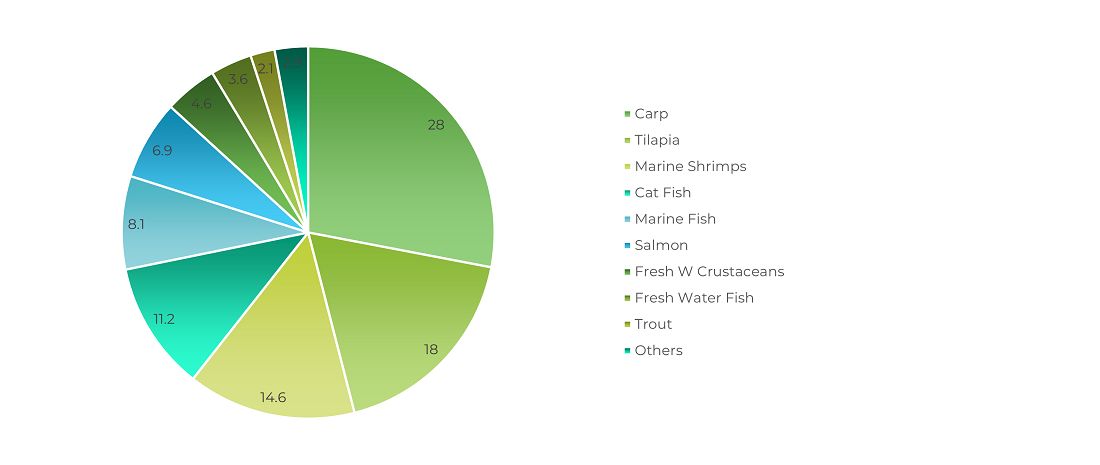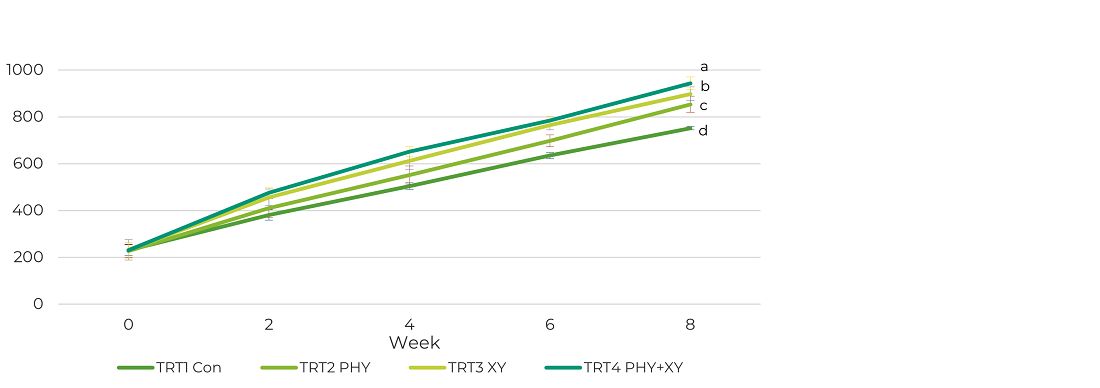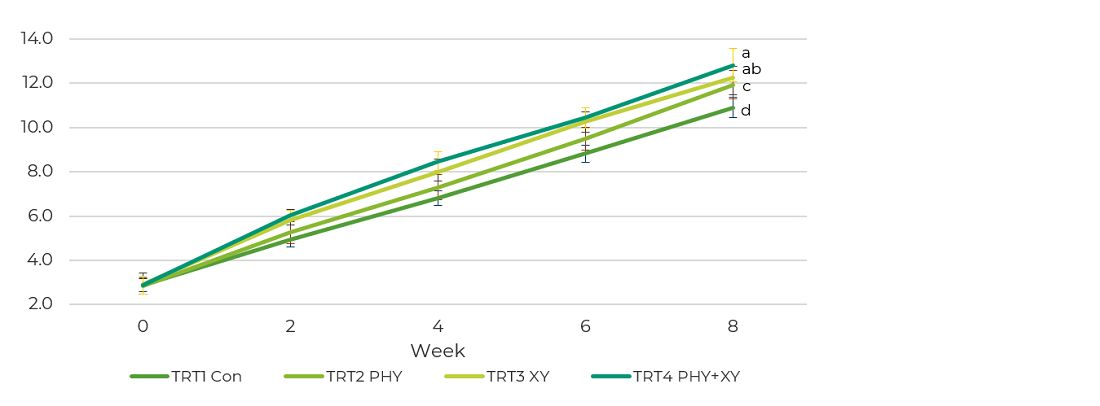Ensuring adequate food and nutrition security for a growing global population is still a daunting challenge. Aquaculture has a permanent role in world food security and supply. Globally, food fish consumption has increased annually by around 3.1%, a growth rate which is higher than all other animal protein foods (meat, dairy, milk, etc.), which are increasing by 2.1% each year. On average, world aquaculture production of farmed aquatic animals grew by 5.3% year-on-year.
Alongside aquaculture growth, the aquafeed markets have followed the same fast-growing trend. Recently, aquaculture feed production grew by 3.7% and is estimated to be around 57 million tonnes. Production is dominated by carps, with approximately 28%, followed by tilapia at 18%, marine shrimp at 14.6%, catfish at 11.2%, marine fish at 8.1%, salmon at 6.9%, freshwater crustaceans at 4.6%, other freshwater fish at 3.6%, trout at 2.1%, and other species accounting for 2.9% (Figure 1).

Trial in carps
Hostazym X is the only fibre degrading enzyme approved by the European Commission to be used in feed for carp species. It is a highly efficient fibre degrading enzymatic complex which increases nutrient digestibility, resulting in better growth performance and a healthier gut environment.
To challenge Hostazym X, a trial was conducted in an outdoor facility at the University of Poznan, Poland. This trial allowed Hostazym X to be tested under adverse conditions where the water temperature fluctuated from 13.5 to 24.7oC and dissolved oxygen ranged from 2.0 to 5.1 mg/l. As is known, low oxygen levels have a big impact on the feed conversion ratio in fish, and growth and health are impacted.
The trial was set up using three different concentrations of Hostazym X; 1050, 1500 and 3000 EPU/kg feed and compared to a control feed without Hostazym X supplementation. Fish oil at 2% was used to coat the extruded diets with the enzyme. A set of 12 ponds with 40m2 were each stocked with 20 x 375 g fish and fed for 90 days. No mortality was observed over the trial duration.
Hostazym X performance for all three levels of inclusion was better than the control group. The results are presented in Table 1 below and show:
- Body weight significantly increased compared to the control group
- Feed conversion rate (FCR) decreased numerically compared to the control group
- Specific growth rate (SGR) decreased numerically compared to the control group

Trial in shrimps
To challenge Hostazym X in crustaceans, a trial was conducted at an outdoor facility at the University of Nakhon Pathom, Thailand. This trial allowed Hostazym X to be tested under farm conditions both alone and in combination with OptiPhos phytase enzyme. Water temperature fluctuated from 27.4 to 29.7oC, dissolved oxygen was above 4 mg/l, salinity around 10 ppt, and total ammonia <1.0 mg/L.
- The trial was set up to compare three treatments against a control diet without enzyme supplementation (Table 2):
- OptiPhos at 1500 FTU/kg feed (PHY)
- Hostazym X at 3000 EPU/kg (XY)
- Hostazym X at 3000 EPU/kg feed + OptiPhos at 1500 FTU/kg feed (PHY + XY)
One coating material at 2% was used to coat the pelleted diets with the enzymes. A set of 20 cages with 2 x 1 x 1.5 m were each stocked with 80 juveniles of 2 g ± 0.03 white-leg shrimp (Penaeus vannamei) and fed for 56 days.

The results in Figures 2 and 3 show statistical differences between the treatments:
- Biomass was higher in the treatments with enzymes added
- The cages with both OptiPhos and Hostazym X added (TRT4) yielded the highest shrimp biomass per cage, followed by TRT3 (Hostazym X), then TRT2 (OptiPhos) and the lowest yield came from the control group (TRT1)
- The shrimp in the TRT4 cage grew, on average, by 12.80 g/individual, followed by TRT3 with 12.24 g/individual, then TRT2 with 11.93 g/individual, and the lowest growth was shown in the control treatment group with 10.90 g/individual


Conclusions
- Both trials performed in cyprinids (carp) and crustaceans (shrimp) show an improvement in growth with the addition of Hostazym X
- The biomass of fish and shrimp produced was higher in the treatments with Hostazym X compared to the control group
- The best result for both species was observed using an inclusion of 3000 EPU/kg feed of Hostazym X
- The use of Hostazym X in combination with OptiPhos seems to have a positive synergy in the growth and yield of Penaeus vannamei shrimp




